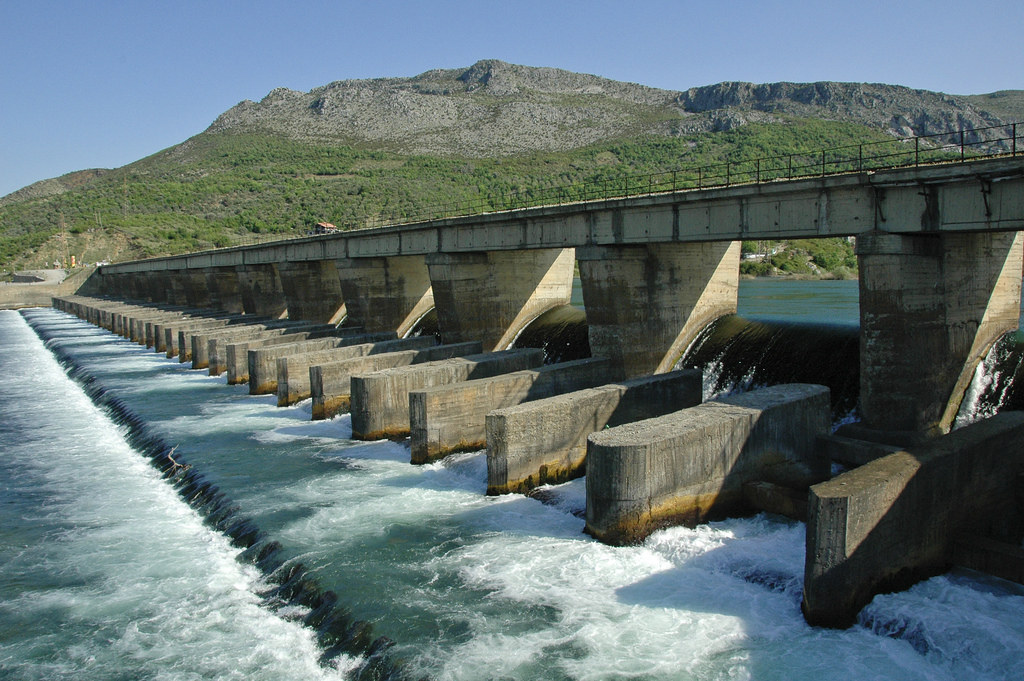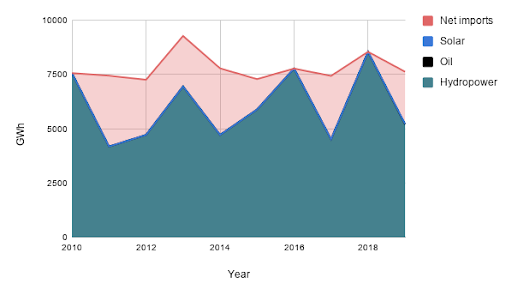
by Pippa Gallop
This second article in our series introducing the new Political Economy of Energy Transition in Southeast Europe – Barriers and Obstacles study by Friedrich Ebert Stiftung Southeast Europe Dialogue and Bankwatch zooms in on Albania, the first of nine countries covered by the report.
Albania, with around 2.8 million people, differs from most of the countries in southeast Europe in its energy mix. Its state-owned power utility, Korporata Elektroenergjetike Shqiptare (KESH), owns three large hydropower plants on the Drin River and a 98 MW gas and oil power plant in Vlora which never started commercial operations due to technical problems.
As of the end of 2019 there were around 200 privately-owned power generation facilities – mainly small hydropower plants – rendering Albania’s power sector completely dependent on hydropower, and in dry years, electricity imports. From 2010 to 2019, Albania met its own electricity demand only three times, despite adding significant new hydropower capacity.

Electricity generation in Albania, 2010-2019. Source: IEA Statistics
The country’s massive electricity distribution network losses – amounting to 21.79 per cent in 2019 – further contributes to its difficulty in satisfying demand.
Around two-thirds of heat is produced by electricity, a fifth by biomass, and smaller amounts by oil and gas. This puts further strain on the electricity sector but also represents an opportunity to leap straight to heat pumps rather than embarking on gasification, which would entail massive investment in infrastructure that would have to be changed again in order to advance the decarbonisation process.
Albania undertook to reach a share of 38 per cent renewables in final energy consumption by 2020, compared to 31.2 per cent in 2009. In 2019, it was close to reaching this target, with a 36.8 per cent share, but final figures for 2020 are not yet available.
Clearly Albania had a favourable starting point in its renewable energy target compared to other countries, but diversification of the energy mix is still sorely needed. Two auctions have been held for large solar installations, but the country’s installed solar capacity at the end of 2019 amounted to no more than 15 MW.
Transition to what?
One of the aims of Albania’s energy transition has to be to reduce the massive fluctuation in its annual electricity generation – as well as the environmental damage wrought by rampant hydropower development.
The country needs to stabilise its electricity generation by diversifying its renewables mix. Its long relationship with hydropower may make it hard to let go, but the situation has long since passed the point where adding more hydropower has any added value. It is time for other energy sources, mainly solar and wind, to make their contribution.
Further reducing distribution losses is a must – throwing away more than a fifth of the country’s electricity is inexcusable and unaffordable.
Decreasing electricity consumption for heating is also key, given the large amount of electricity which goes for this purpose currently. This represents a great opportunity to roll out greater use of heat pumps in the residential sector, which would use much less electricity and avoid the need for increased use of biomass or gas. The Trans Adriatic Pipeline may be physically present in Albania, but it must not lead to a new lock-in for the country.
In the transportation sector, Albania is just as fossil fuel-dependent as other countries in the region. This sector uses the most energy in the country, so this certainly needs to be addressed as well – both by decreasing overall energy usage, as well as by electrification. Albania’s low level of public transport means that any investments being made (e.g. in railway rehabilitation or new buses) can go straight for electrification. Electric cars can make a contribution and infrastructure should be provided, but expensive subsidies to buy electric cars that benefit mostly already relatively well-off car owners must be avoided. Non-motorised transport can also make a much greater contribution. Some efforts are being made along these lines in Tirana and other cities, which should be continued and increased.
Albania is one of the few Balkan countries producing oil – 1,005,000 tonnes in 2019. The state-owned Albpetrol is active in the development, production and trade of crude oil, while the largest oil producer is Bankers Petroleum, now Chinese-owned. So far the country is far from phasing out oil production, but planning needs to start now.
Why is Albania’s energy transition not advancing more quickly?
State capture, a lack of transparency in energy sector decision-making and lack of rule of law are clearly major problems. Concessions and other approvals for hydropower plants have been handed out in almost total secrecy, and the true number of new hydropower plants approved by successive governments is unclear even now, with journalist Artan Rama calculating in 2019 that the real number is around 250 higher than the officially cited figures.
Among other things, these issues lead to very poor application of laws that would help to prevent environmental harm. For example a construction permit was issued for the Dragobi and Cerem hydropower plants in the Valbona National Park without the relevant environmental approval. And when the construction permit expired, construction continued, with no consequences.
False solutions
Hydropower is still very much promoted, despite Albania’s dependence on it and the resulting annual variations in electricity generation. But fossil fuels are also knocking at the door.
Albania is not connected to international gas networks at the moment, though the controversial Trans Adriatic Pipeline has been built across its territory. The country produces a small amount of gas, mostly used in oil production and the refining industry. But there is a danger of Albania making a partial transition to – not away from – fossil fuels in the coming years.
The government has adopted a Gas Master Plan which plans to increase the share of gas in the total primary energy supply from 0.4 per cent in 2013 to 28 per cent in 2040 and to build three gas-fired power plants. Albania’s National Energy Strategy also plans around 200 MW of gas power plants, arguing that they can replace imports. It remains to be seen whether these plans will be realised, moving the country backwards in terms of decarbonisation, and locking in fossil gas infrastructure.
Lack of expertise and experience
Albania’s decision makers overall see the benefits of renewables such as solar and wind, but lack experience on implementing such projects in practice. There is a relatively high amount of engineering expertise, but much less management expertise and legal expertise connected to the wider market reform agenda, which may end up meaning that Albania does not benefit as much as it should from the ongoing changes. As with some of the other countries in the region, much of the expertise comes from outside through donor projects, without really building domestic capacity, and brain drain is a serious issue.
What is needed to overcome the barriers to a sustainable energy transition in Albania?
Albania has some advantages which should make its energy transition easier than for other countries in the region – notably the lack of fossil fuel power generation and coal mining. But it has similar risk factors connected to corruption and low government capacity.
To put the necessary transition into action, much stronger action to apply the rule of law is needed. Decision makers need to be accountable for their actions, clear follow-up is needed on pledges made, and genuine public consultations must be carried out on policy matters, particularly those with environmental impacts.
In a decentralised, renewable-energy-based electricity system, appropriate spatial planning and nature protection is arguably even more essential than in a centralised one. Albania needs to do much more to provide real protection to valuable natural areas and to properly enforce environmental legislation.
Greater public participation is needed across the board, not only to prevent harmful projects, but even more so to move forward with increasing energy efficiency and citizen energy, both of which offer huge opportunities for the country.
Featured photo shows Ashta HPP, by Flickr user IFC Infrastructure, used here under a creative commons licence.
